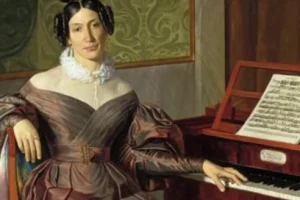Beyond Rossini’s Muse: Isabella Colbran as Developmental Repertoire for the Young Singer

As applied voice teachers continue efforts to diversify the vocal canon and highlight underrepresented composers, one significant name still often overlooked is Isabella Colbran (1785–1845). A Spanish dramatic soprano and prolific composer once celebrated as the “Siren of Naples,” Colbran’s contributions offer unique pedagogical value for today’s voice studio. Though best known as Rossini’s muse and first wife, Colbran was also an adept composer whose art songs serve as valuable pedagogical tools for the 21st-century studio. Her works offer 19th century bel canto technical development, approachable range/tessitura for young voices, and dramatic clarity. Through study and performance of her work, young singers can expand their stylistic and historical understanding of the 19th century bel canto era.
Much like many women composers of the 19th century, Colbran has been eclipsed by the men who wrote for her, most notably Rossini. Her twenty-four art songs, (collected in her 6 Petits Airs Italiens) offer insight into the 19th century bel canto idiom through the unique lens of a woman singer-composer. Rooted in the technique she absorbed from Girolamo Crescentini, Colbran’s teacher and one of bel canto’s most influential pedagogues, her compositions prioritize legato line, appoggio, and dramatic expression. These elements are cornerstones of healthy vocalism for the emerging singer and incorporating her repertoire into the studio can provide an excellent supplement to a singer’s habilitation plan.
Colbran’s songs are often ABA or strophic with supportive keyboard (or harp) accompaniment that reinforce tonality and rhythm without doubling or overpowering the voice. This balance makes them especially useful for singers who are developing musical literacy. Her work generally avoids extreme tessituras, includes moments of textual repetition that coincide with the da capo form, and emphasizes lyrical rather than virtuosic expression, though coloratura does emerge throughout her work.
For the teacher, her focus on bel canto technical development means a low-risk, high-reward addition to the student’s repertoire list. For the student, it means growing vocal independence and stylistic awareness. For more advanced students, teachers can use Colbran’s work to introduce composing simple cadenzas, adding ornamentation on da capo sections, and navigating messa di voce. These elements not only refine the technical foundation but also connect the student to a historical performance practice.
Take for example, her piece “La speranza al cor mi dice.” This short song, set to a text by Pietro Metastasio, expresses a sentiment of longing to love again, but a fear of being hurt. The simple text provides young singers the opportunity to explore emotional nuance and dynamic variation. With a moderate range (D#4–A5) and even phrase length, it allows the teacher to address breath management, appoggio, and vowel consistency, all motivated by text expression. Mastering these skills is essential for singers preparing for more advanced bel canto repertoire.
In my own studio, assigning Colbran has led to exciting growth. One first-year soprano working on developing consistent breath flow without collapse found confidence in “Ch’io mai vi possa lasciar d’amare,” using the piece’s coloratura and emotional expression to connect to her breath. Another student, a first-year mezzo with strong musical instincts but little exposure to ornamentation, was first intimidated by the ending cadenza but flourished when invited to explore her own ideas in “T’intendo, si, mio cor.” In both cases, the repertoire provided a technical workout, a historical connection, and a dramatic playground—a trifecta when choosing pieces for developing voices.
Colbran’s music also serves a broader curricular goal: diversifying the canon. 19th century bel canto canon has long centered on a narrow list of composers, most of which excludes contributions from women composers. By incorporating Colbran into undergraduate juries, recital programs, and competition selections, we challenge ideas about what works should be included in the canon and history of Western European classical vocal music. Transcriptions of 6 Petits Airs Italiens are available via IMSLP, and modern transcriptions can be found in collections including Women Composers: A Heritage of Song (Hal Leonard).
As vocal pedagogues, we are required not just with building vocal technique, but with developing young artists. By assigning and advocating for composers like Colbran, we empower emerging singers to explore repertoire that reflects the full scope of their musical heritage—including the voices history nearly forgot. In bringing Isabella Colbran into the studio, we aren’t just reclaiming a name; we are reclaiming a legacy of skill, strength, and artistic insight. Her music cultivates technique with expression and in doing so, ushers in the potential for how young artists can continue to shape the ongoing evolution of Western European classical vocal music.
Suggested songs by Isabella Colbran for the developing singer:
- “La speranza al cor mi dice”—ideal for early undergraduates; focuses on appoggio, messa di voce, and preparation for coloratura.
- “T’intendo, si, mio cor”—suitable for intermediate singers exploring chromaticism, appoggio, and coloratura.
- “Ch’io mai vi possa lasciar d’amare”—excellent for developing intermediate coloratura, fast Italianate patter, phrasing and emotional arc.
